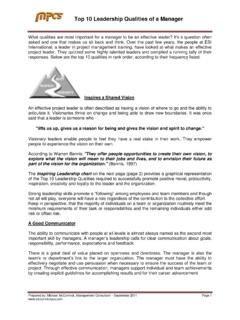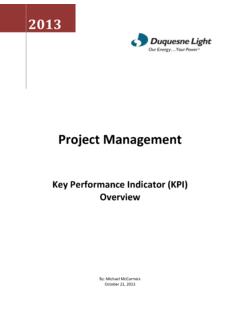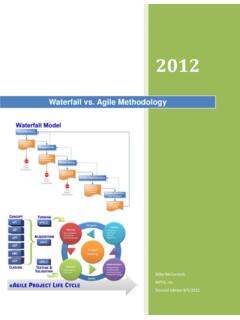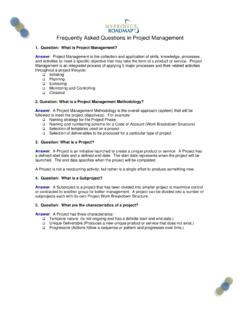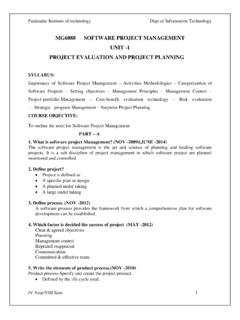Transcription of Enterprise Project Management Office (ePMO)
1 Enterprise Project Management Office (ePMO) Prepared by: Michael McCormick, Management Consultant September 2011 Page 1 Overview Many Project Management offices (PMOs) are not successful in addressing the strategic priorities of their organization because they are departmentally based and not Enterprise -wide. This reduces their span of influence and limits corporate support. Current PMO trends demonstrate that PMO s are more effective and can better impact the bottom line, when they are operating at the corporate Enterprise -wide strategic level, rather than at the departmental level. Current trends indicate that all levels within an organization typically do not embrace the direction of the PMO. However, headed departmentally based PMOs indicates that all levels of their departments embraced the direction of the PMO. This suggest that departmentally based Project Management offices are successful in their own silos but not accepted outside their span of influence, and therefore, are unable to influence the organization as a whole.
2 An examination of the traditional Project Management Office model compared to the more current corporate-wide ( Enterprise ) approach helps in building this case for moving the PMO to this more strategic, Enterprise -wide position. The Traditional Project Management Office (PMO) Most Project Management Offices are located only within a department in their organizations. Generally these Project Management offices are relegated to the IT or Engineering department. They struggle to maintain a strategic orientation because they are not set-up to affect the entire organization. This is because many Project Management offices started off from a grass roots approach. They were started by an individual or small group of individuals who saw the need to bring more control over the Management of a portfolio of projects, which, although based on good intentions, lacked senior Management s direction and control.
3 Typically, the initial effort on the part of the PMO usually included presentations to increase departmental awareness and provision of training for the Management team to help ensure their understanding. This helped the PMO to move from a grass-roots approach into a more formal structure. Generally, these Project Management Offices gained success through their department. Their success increased when they were able to get executive sponsorship for their efforts but this was not always the case. In fact, during the past 5 years PMO s have demonstrated that executive sponsorship was a critical requirement for PMO success and lack of it was a key reason for failure of the PMO. The Enterprise Project Management Office (ePMO) The next evolution of the Project Management Office is for it to move into the corporate side of the business. This allows the PMO to gain a strategic position within the organization and works to ensure that projects proceed on the basis of their strategic alignment to the objectives of the organization.
4 A PMO that is organizationally based versus departmentally based is more likely to get executive support. After all, Project Management should not be a departmental strategy; it should be an organizational strategy. The senior Management team can demonstrate a strong commitment to this ePMO by requiring all Project teams to adopt the process, tools and templates of the ePMO. The ePMO should ensure projects are aligned with corporate strategy and direction. Senior executives are most concerned with Enterprise Project Management Office (ePMO) Prepared by: Michael McCormick, Management Consultant September 2011 Page 2 how an ePMO will positively impact the organization as a whole, each individual department, and their customers. In some organizations, the ePMO will oversee the Management of all strategically aligned projects. In larger organizations, the ePMO will have departmentally-based PMOs reporting directly to them.
5 This provides them with an opportunity to align all corporate-based and departmentally based projects against the strategic plan and to manage Project prioritization and resourcing issues. Below is an example of what the ePMO structure looks like: Measuring the Impact of the ePMO The ePMO is more likely to receive continuous support from the Management team if they can provide both quantifiable and qualitative data on projects that they are responsible for overseeing on a weekly or monthly basis. This data can include a comparison of the number of projects as well as the changes that have occurred since the implementation of the ePMO. It includes the number of projects that: Were completed within their time constraints since the implementation of the ePMO as compared to the number of projects completed within their time constraints prior to the implementation of an ePMO. Enterprise Project Management Office (ePMO) Prepared by: Michael McCormick, Management Consultant September 2011 Page 3 Were completed within their budget constraints since the implementation of the ePMO as compared to the number of projects completed within their budget constraints prior to the implementation of an ePMO.
6 Meet or exceeded the customer requirements specifically identified at the beginning of the Project . Aligned with corporate strategy (Alignment should be 100%). Have successfully been managed (on-time, on-budget, met customer expectations) after training of Project managers and team members as compared to projects managed by individuals not formally trained. Followed the prescribed ePMO Project Management process and were completed successfully as compared to projects that did not follow the prescribed ePMO Project Management process. Applied a risk Management process with fewer crisis situations, as compared to those projects that did not apply risk Management . Realized a reduction in cycle time from order to delivery or from product design to product launch. Simplified by making transparent a complex Project for the customer, supplier and third parties. Utilized staff with appropriate skill sets for the Project .
7 EPMO Structuring Guidelines A reporting structure in which the ePMO reports directly to one or more members of the senior Management team increases the likelihood for timely approvals and decisions regarding projects and generates greater visibility and acceptance for the ePMO by the rest of the organization. Furthermore, correctly structuring the ePMO requires consideration for the authority of its leader. The head of the ePMO must have the same Management level as the managers of the functional departments from which they will need to draw staff for the Project team. This will help the ePMO to focus on the interests of the organization as a whole rather than on the interests of any particular functional group. It will also ensure that the ePMO is able to resolve any conflicts that may arise between projects competing for common resources. A current approach to the structuring of the ePMO is to have anyone who manages a Project reporting to a functional manager rather than to the ePMO.
8 Current ePMO s indicates that this matrix Management structure tends to reduce the hierarchy of the ePMO and it ensures it is able to stay focused on coaching and mentoring all Project managers rather than the more time consuming role of managing all Project managers. The ePMO should engage the senior Management team to visibly support it and its Project Management approach. They can do this by coaching senior Management through the approval process to ensure timely approvals are given for Project Description Statements, Milestone Reports, Project Change Requests and other key Project documentation as required in the Project Life Cycle Framework (PLCF). As well, the ePMO should review each of these documents with the Project Manager to ensure that the documentation is clear and accurate before presenting to the member of senior Management who acts in the role of sponsor for the Project . This will reduce the need to coach the senior Management on every detail of each document before they agree to its approval.
9 Enterprise Project Management Office (ePMO) Prepared by: Michael McCormick, Management Consultant September 2011 Page 4 It is important for the ePMO to provide early warning signs to Management about difficulties that projects may be facing. While senior Management does not have the time to examine individual, detailed reports on each Project , nevertheless, they do want to be kept up to date on the progress of all projects. Therefore, it is preferable for the ePMO to maintain a regular practice of communicating and reporting to the senior Management team through an integrated report that combines all projects into one report. This report should indicate; projects are on-track, projects off-track, and projects experiencing serious problems (risk). This provides early warning signs to Management of difficulties that may be occurring with any Project . Today s key reporting tool is the dashboard which provides a quick visual status of the projects within the Project Portfolio Management framework (PPM).
10 Lessons Learned from projects and customer feedback are other forms of communication with the senior Management team that will generate added support from them as continuous improvement is applied. Summary A PMO that is structured to manage projects across departments, locations and regions is best implemented on an Enterprise -wide basis. This is because it will hold the responsibility for ensuring consistency in the Management of all elements of each of these projects and will also be able to assess and prioritize each Project for alignment with the corporate strategy. The goal of an ePMO is to help their organization effectively manage projects in today s complex, global marketplace. The successful Management of these projects has a direct impact on the organization, its customers and its resources. The ePMO Flow Chart on the next page reflects the various interfaces within an organization. Enterprise Project Management Office (ePMO) Prepared by: Michael McCormick, Management Consultant September 2011 Page 5 Enterprise Project Management Office (ePMO) Prepared by: Michael McCormick, Management Consultant September 2011 Page 6 Best Practices for Implementing a Project Management Office Organizations moving towards the implementation of a Project Management Office (ePMO) must consider many factors before taking the first steps.
